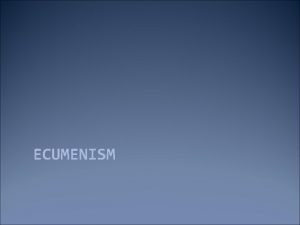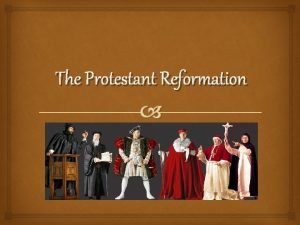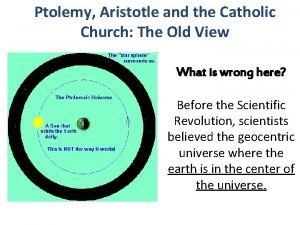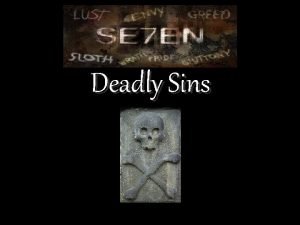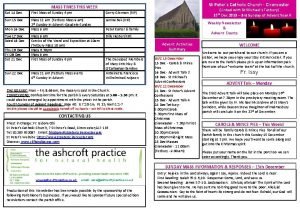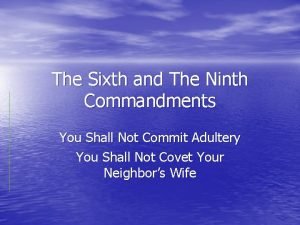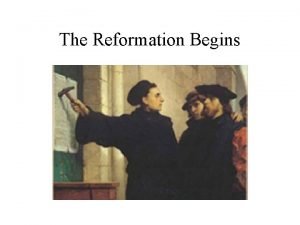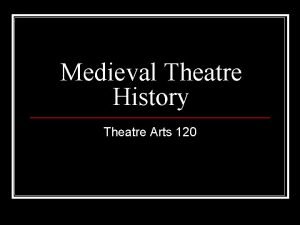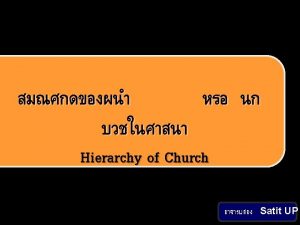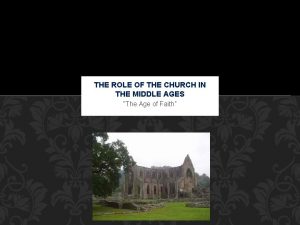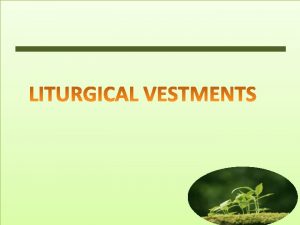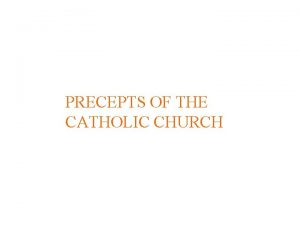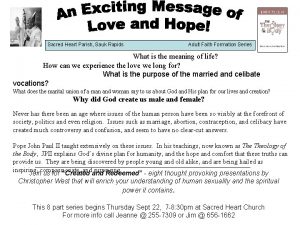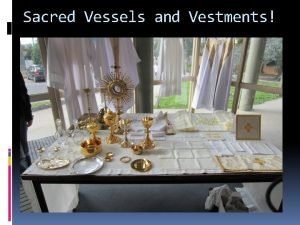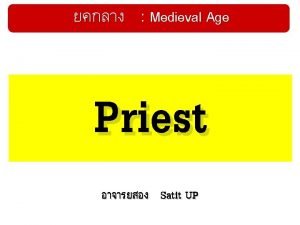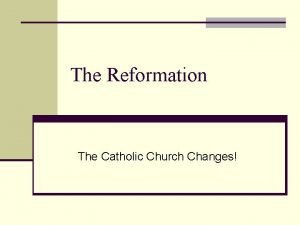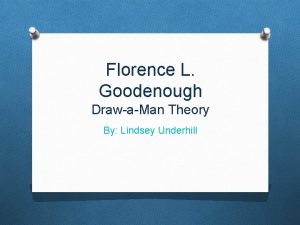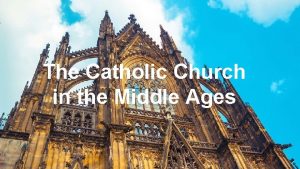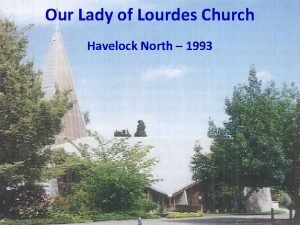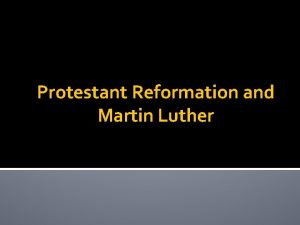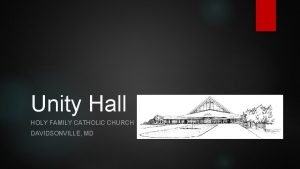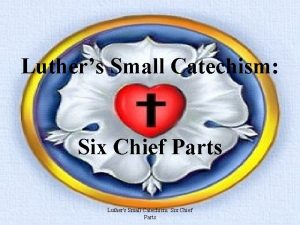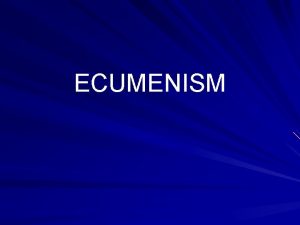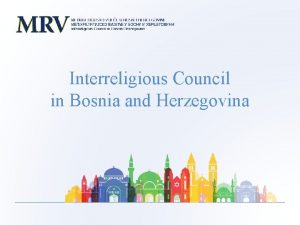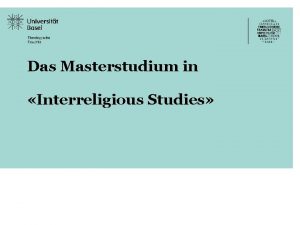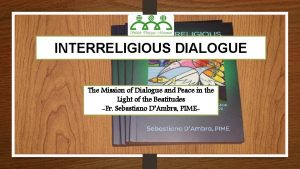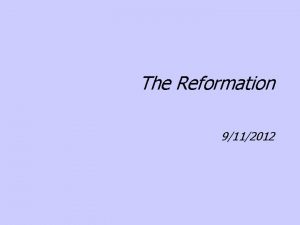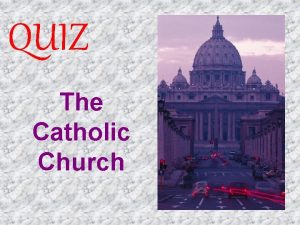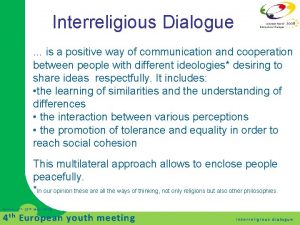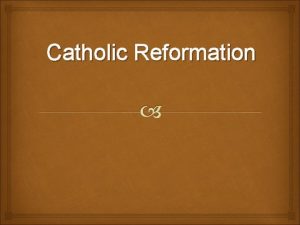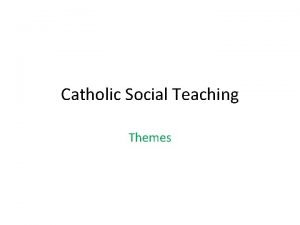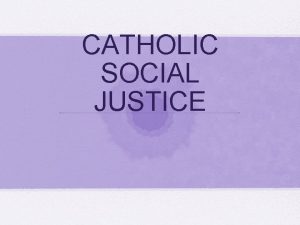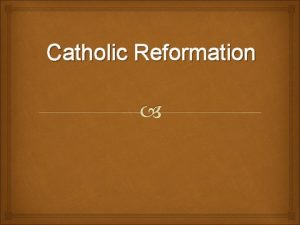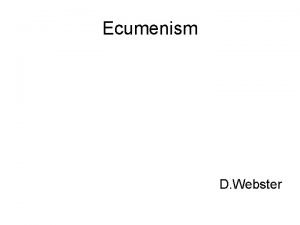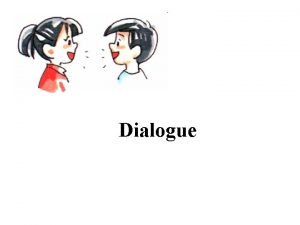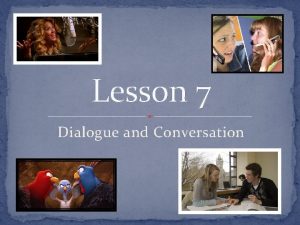The Catholic Church Ecumenism Interreligious Dialogue Ecumenism v
























































- Slides: 56

The Catholic Church, Ecumenism, Interreligious Dialogue

Ecumenism v. Interreligious Dialogue O Ecumenism: focused on Christian unity O Healing schisms O Interreligious Dialogue – focused on promoting unity among all religions, not just within Christianity

Catholic Attitude Toward Ecumenism O Historical events make the Church hesitant about ecumenism O Hard feelings over the East-West Schism O Hard Feelings over the Protestant Reformation O Violence of the Enlightenment

What Changes? O Time heals all wounds O Renewed appreciation for Jesus’ words: “That all of them may be one, as you, Father, and I are one. ” O Rise in hostile secularism

Assyrian Church of the East O Nestorius – Archbishop of Constantinople (d. 450) O Taught that Christ is two persons – one divine person with a divine nature, which dwells in a human person with a human nature O Thought this was necessary in order to take Christ’s humanity seriously O Because Christ is two persons, not one, Mary is the Mother of Jesus but not the Mother of God

Assyrian Christians II O St. Cyril (Bishop) of Alexandria opposes him O If Christ is two persons, how do they coordinate their actions? O How do we avoid a schizophrenic Jesus? O How are we saved if the actions of Christ aren’t the human actions of God?

Assyrian Christians III O Council of Ephesus is O O convened to settle it (431 A. D. ) Nestorianism is condemned – Christ is one person Nestorius’ followers flee beyond the borders of the Roman Empire Present day Iraq and Iran (hence the name “Assyrian”), parts of southern Turkey, Northern Syria, China, and India Currently around 500, 000 Assyrian Christians worldwide

Assyrian Christians IV O Assyrian Christianity looks O O O similar to Eastern Orthodoxy and Catholicism Similar understanding of sacraments (real contact with Christ, communicate grace) Very ritualistic liturgy (in Aramaic) Hierarchical leadership (bishops under Catholicos Gewargis III, the current patriarch) Heavy emphasis on tradition and saints But a heretical Christology

Oriental Orthodox O Eutyches (monk - d. 456) O O tries to stamp out what’s left of Nestorianism Teaches that Christ had only one nature (a divine one) Christians who hold this view were called Monophysites If a human nature really was united to the divine Son, how could it remain human like us? So Christ doesn’t really have a human nature at all - it’s been transformed into part of his divinity

Oriental Orthodox I O Bishops and theologians realize that if Christ has no humanity, then our humanity isn’t healed O Council of Chalcedon is convened (451 A. D. ) O Rules that Christ has a real human nature like ours (without sin) but that it’s united to his divine nature to make a single person (2 natures, 1 person)

Oriental Orthodox II O The Monophysites either leave the Empire voluntarily, are exiled, or the invasion of Muslim armies changes the religious landscape entirely, so all Christians become second-class citizens O “Monophysite” is sort of derogatory now; they’re called Oriental Orthodox today

Oriental Orthodox III O The “homelands” of Oriental Orthodoxy are: Egypt, Ethiopia, Armenia, Syria, parts of Iraq, Iran, and Turkey O Currently about 86 million Oriental Orthodox Christians world-wide

Oriental Orthodox IV O Current Oriental Orthodox Patriarchs: O Coptic (Egyptian) Orthodox: Pope Tawadros II O Syrian Orthodox: Patriarch Ignatius Aphrem II O Armenian Orthodox: Catholicos Karekin II

Eastern Orthodoxy O Bible (written word) and O O O Tradition (spoken word) are twin sources of revelation Interpreted in light of each other Tradition is safeguarded by the teachings of the saints, the first seven Ecumenical Councils, and the prayers, hymns, and liturgy of the Church Lex orandi, lex credendi The rule of prayer is the rule of belief Bishops and patriarchs have an important but secondary role in safeguarding the faith

Eastern Orthodoxy II O A decentralized Church (churches, really) O Unity is in unity of Tradition, not unity under a single leader O One of the main points of disagreement with the Catholic Church – role of the Pope (supreme pontiff, like in the Middle Ages, or a “first among equals, ” like in the early centuries)

Eastern Orthodoxy III O This is why the Orthodox reject filioque (“and the Son”) in the Nicene Creed – it’s an addition to the faith undertaken without approval from all bishops O This is why they reject the Immaculate Conception of Mary (though they accept the Assumption) O This is why they reject papal infallibility

Eastern Orthodoxy IV O Other distinctive things: O Generally much more comfortable with mystery O Avoid systematic theological thinking when possible O Apocatastasis: universal salvation O Different understandings of Purgatory and Original Sin – mostly Western ideas, though Eastern Christians find them acceptable when they’re expressed a certain way

Protestantism

Protestantism I O Direct, unmediated access to God is central to Protestantism O The individual alone before God O The first Reformers revolted against the mediating institutions of early and medieval Christianity (sacraments, hierarchy, saints, philosophy, etc. )

Protestantism II O Philip Schaff (Protestant historian): “The Protestant goes directly to the Word of God for instruction, and to the throne of grace in his devotions. This general principle of Evangelical freedom, and direct individual relationship of the believer to Christ, proceed the three fundamental doctrines of Protestantism – the absolute supremacy of (1) the Word, and of (2) the grace of Christ, and (3) the general priesthood of believers”

Protestantism III O The individual Protestant is O O O to meet God through the Word of God (The Bible) By sitting down with his or her Bible and reading No magisterium for guidance No Tradition for direction Those things would take away from the supremacy of the Word (Sola Scriptura) That’s why Protestant services tend to consist mostly of a reading of and preaching on the Word (pulpit is at the center of the service, not alter)

Protestantism IV O Sacraments less important O O O because: 1). Scripture is primary; sacraments would take away from that and, moreover, most of the Catholic sacraments are unscriptural 2). Not comfortable with the idea that God would put his grace at the mercy of our physical symbols (damages his sovereignty) 3). Grace can’t fix us on the inside anyway because of the severity of original sin - so the sacraments that are scriptural are just symbols We’re saved by faith alone, which “covers” us (sola fide) and which is itself a grace (a free gift, unearned – sole gratia) No human response necessary or possible

Judaism

Judaism O Orthodoxy vs. orthopraxy O Right belief vs. right conduct O Judaism tends to emphasize orthopraxy O Makes it difficult to pin down exactly what Jews believe

Judaism II O Rabbi Maimonides’ 13 O O O principles of Jewish belief (the bare minimum a Jew must believe): God exists He’s one He’s immaterial He’s eternal Worship (prayer) is to be directed to God alone

Judaism III O The words of the prophets O O O O are true Moses’ words have priority Written and Spoken Torah come from God himself There will be no other Torah and therefore it can’t be changed God is omnipotent and omniscient God will reward the good and punish the wicked The Messiah will come The dead will be resurrected

Judaism IV O Most estimates say there O O O O are 13 million Jews in the world, divided into three main sects Orthodox Judaism (10% of American Jews) Most traditional sect Strict observance of Torah Payot (pr. Pie-yote) – long curly sideburns: Leviticus, “Do not round off the corners of your head” Dietary Restrictions Modest Dress Covered heads during prayer, at least

Judaism V O Conservative Judaism (about O O O 18% of American Jews) There can be some evolution within Torah We can weed out those parts of Torah that are merely expressions of an ancient culture, and keep those elements that are divinely given and cannot evolve So, it’s a moderate form of Judaism Some modifications to dietary restrictions, women may be rabbis, but value etc. Most conservative Jews follow most of the laws some of the time, but not all of the laws all of the time

Judaism VI O Reform Judaism (35 -40% of American Jews) O Most liberal sect O Arose in the 18 th century in response to Enlightenment and rise of political liberalism – caved to it O Women in leadership roles, LGBT-friendly, less interested in the geography of Israel, lax about law, deeply interested in social justice

Judaism VII O Jews use a lunar calendar (each month begins on the new moon), during which the following holidays are celebrated: O Rosh Hashanah (New Year – a time for introspection)

Judaism VIII O Yom Kippur: holiest of days – the day of atonement, for repentance and conversion O Sukkot: Feast of Booths – temporary dwellings of Israelites; lasts 7 days, joyous celebration

Judaism IX O Shavu’ot: celebrates the giving of the Torah – 50 days after Passover; stay up all night reading Torah; eat meal of dairy to remember land of milk and honey

Islam O Judaism, Christianity, O O and Islam are all commonly described as religions of the book It’s a lazy description Judaism’s existence doesn’t rest on a book Judaism exists long before the Hebrew Scriptures are recorded Judaism is a religion of a nation, which produced a book

Islam II O Neither is Christianity a religion of the book O It’s a religion of The Word, the person Jesus Christ, and the community that arises around that person O The Book is written once Christ’s disciples realize Jesus ain’t coming back anytime soon

Islam III O Of the three, really only Islam is O O a religion of the book in the strict sense God himself is the author of the Quran Mohammed is the scribe who dictates at the very beginning of his mission/ministry Holy books of Jews and Christians are written by men who are aided by God, in such a way that they don’t teach error concerning God, but they can contain errors of fact For Islam, the Quran cannot contain error, contradiction, or supersedable content

Islam IV O This understanding of inspiration O O O O creates interpretation difficulties No magisterium in Islam Example: Jihad – can mean interior spiritual struggle; can also mean violent military conflict Early Quranic suras are peaceful (written prior to Muhammed’s military power); violent conflict is spoken of much more frequently in later suras (after Muhammed gains military power) Who resolves this tension? So, there are peaceful Muslims, and then there are Muslims like Osama bin Laden Hard for one Muslim to tell another: “That’s not true and authentic Islam”; the best they can say is “Your understanding of Islam is not mine” 4 main themes in Quran:

Islam V O First, all creation is Muslim in the O O O beginning (Islam = submission; Muslim = one who submits) Because of The Fall, man is weak and must follow the divinely sent prophets back to God, all of whom preach the same message Abraham, Moses, Jesus, etc. , and, finally, Muhammad Humans don’t need “salvation” – we just need to follow the prophets Muhammad is sent because the message of the previous prophets was distorted So, from the Muslim perspective, Muhammad isn’t the founder of Islam, he’s the restorer

Islam VI O Second, the message of these prophets and, finally, the Quran: That there is no god but God, and that we must do good and avoid evil O So, Trinitarianism is rejected as Tritheism O God: all-loving, allpowerful, all-knowing, all-merciful, omnipresent O 99 names of God – for contemplation

Islam VII O Third, to do good and avoid evil O O O primarily means to follow Shariah Law Composed from parts of the Quran and Sunnah (a book detailing Muhammed’s way of life – distinct from Quran…. Hadith is something similar) Shariah spells out expectations for moral living Teaches against things like murder, drunkenness, sexual promiscuity, obligations for prayer, etc. Those who do the will of God will receive eternal reward on Judgment Day But the goal of the Muslim community is to create an environment in which it’s easy to do good and avoid evil

Islam VIII O Fourth, expectations for a Resurrection of the Dead (“The Hour”) O Every person will stand alone before God answer for his or her life and receive punishment or reward O Because humans are bodily creatures, the Quran and subsequent Muslim tradition has tended to emphasize the physical nature of reward/punishment (72 virgins in heaven, for example)

Islam IX O Sacred Time – similar to O O Catholics and Jews Prayer 5 times a day Ramadan – monthly fast honoring the reception of Muhammed’s first revelation from God Festival of Breaking the Fast – end of Ramadan Festival of Sacrifice – celebration of the end of the Hajj, and a commemoration of Abraham’s willingness to sacrifice Ishmael

Islam X O O O O Three Abrahamic religions? It’s a Christian expression Islam doesn’t typically think of Judaism and Christianity as “Abrahamic religions” Quran, III, 67: “Abraham was neither a Jew nor a Christian, but a true believer and Muslim…. ” Quran, II, 135: “They have said: ‘Be Jews or Christians, you will be well advised. ’ Say: ‘But no!. . . Follow the religion of Abraham, a true believer who was not numbered among the polytheists’” Only Islam is the religion of Abraham The other two religions are deformations or betrayals of revelation

Buddhism I O Not a God-centered O O religion Some describe it as an atheistic religion Some say it’s closer to an a-theistic philosophy Focus is on individual human awakening or enlightenment about what’s real Its founder, Siddahrta Gautama, is known simply as the Buddha – “The awakened one”

Buddhism II O Some Buddhists believe the Buddha had an element of divinity, but primarily they’re interested in imitating his life to reach Nirvana, not worshipping him O Nirvana – the extinction of suffering, impermanence, delusion…. anything that keeps us from discovering reality O Any sign of respect toward statues or images of Buddha is a sign of respect only, not worship

Buddhism III O The Buddha wrote nothing, O O O but his teachings and acts were recorded by later generations Not necessarily historical No agreement within Buddhism about what’s authentic and sacred and what’s not, but two texts are revered by all: Pali Canon Lotus Sutra All scriptures are meant to educate people in the Four Noble Truths of Buddhism, and help them along the Noble Eightfold Path toward Nirvana

Buddhism IV O Four Noble Truths: O Life is full of suffering O Suffering is caused by desire O To cease suffering we have to cease desiring O The Noble Eightfold Path is the way to stop desiring

Buddhism V O Noble Eightfold Path: O Right understanding O Right thought O Right speech O Right conduct O Right livelihood O Right effort O Right mindfulness O Right concentration

Buddhism VI O The points on the path either deal with morality, meditation, or wisdom O Moral acts bring about meditation, meditation brings about wisdom, and wisdom gives rise again to moral action (it’s a circle) O You experience samsara (cycle of rebirth/reincarnation) until you’ve rooted out desire through the Eightfold Path and achieved Nirvana

Hinduism I O Maybe the world’s oldest religion (depending on how you date the founding of Judaism) O Doesn’t really have a founder O Sort of an adaptation of preexisting Indian religions

Hinduism II O Hindus are pantheists O The world is part of God, rather than distinct from him (though Hindus wouldn’t describe God as “him” – God’s too mysterious to be personal) O So, Hindus have no real doctrine of creation like Christians, Jews, and Muslims O Rather, creation emerges from God as part of him

Hinduism III O O O O O It’s a remarkably flexible religion No creeds or professions of faith, though there are basic beliefs that all Hindus would hold in common Believers are encouraged to imagine a god that works best for them To adopt parts of other religions that work for them Ask a Hindu how many gods he has and he’s likely to say 330 million Though many Hindus will say they’re all just different images of the one ultimate, incomprehensible god, Brahman doesn’t have attributes like the God of Judaism, Christianity, and Islam He’s so transcendent, nothing about him can be grasped He’s the life-force of the universe, and we all share in this force

Hinduism IV O O O O O Hindus see life as cyclical, not linear (similar to Buddhism) Series of re-births (Samsara) Karma determines what form you take in the next life (caste system) The series of re-births ends when the individual reaches moksha (liberation) Moksha is true self-realization Living a good life now puts you in a better position in the next to reach moksha It’s when a person finds his or her true self, his or her atman (soul) which is identical with Brahman himself This is difficult – we reach this goal through rigorous physical and mental discipline You do this through yoga

Hinduism V O Yoga consists of three different disciplines – knowledge, good deeds, and devotion O Yoga removes the negative karmic effects on the soul and moves it toward liberation

Hinduism VI O Brahman is in everything, not just the human soul, which makes everything sacred to Hindus O Non-violence is standard Hindu belief O Vegetarianism isn’t universal, though many Hindus are because it reduces damage to life

Hinduism VII O Hindus have sacred time, but few festivals that all Hindus celebrate in common O Important festivals: Diwali and Holi O Important life cycle events: Hair parting, Rite of birth, Name-giving, Ear-piercing, Beard shaving, Marriage, Cremation, Scattering of ashes O If properly observed, these stages can ward off bad karma and a person can get a better re-birth

Hinduism VIII O Hindu temples and shrines are O O O generally consecrated to one god Worship services are rarely congregational Typically a priest (brahmin) offers puja to the god or goddess of the temple Puja – a welcoming of the particular god, and an offering or sacrifice of flowers, fruit, grain, etc, An imitation of what nature (and thus god) is already doing for you – giving and welcoming Minimal participation from the people
 Interreligious and international federation for world peace
Interreligious and international federation for world peace Ecumenism definition
Ecumenism definition Ecumenism def
Ecumenism def Receptive ecumenism definition
Receptive ecumenism definition Congratulation expression
Congratulation expression Catholic v protestant
Catholic v protestant Problems in the catholic church reformation
Problems in the catholic church reformation Aristotle catholic church
Aristotle catholic church 7 mortal sins catholic church
7 mortal sins catholic church Catholic church cirencester
Catholic church cirencester Corruption in the catholic church
Corruption in the catholic church Sixth commandment catholic
Sixth commandment catholic Christian denomination comparison chart
Christian denomination comparison chart St ann arlington
St ann arlington Branches of catholic church
Branches of catholic church Finchley catholic church
Finchley catholic church The weakening of the catholic church
The weakening of the catholic church Why did the catholic church introduce tropes?
Why did the catholic church introduce tropes? Clergy ranks
Clergy ranks Church hierarchy christian
Church hierarchy christian Liturgical vestments meaning
Liturgical vestments meaning Five precepts of the catholic church
Five precepts of the catholic church Catholic church ranking system
Catholic church ranking system Sacred heart church sauk rapids
Sacred heart church sauk rapids Sacred vessels
Sacred vessels Ranks of the catholic church
Ranks of the catholic church Lutheran vs catholic
Lutheran vs catholic St albans church finchley
St albans church finchley Florence l. goodenough
Florence l. goodenough With lines
With lines Structure of catholic church
Structure of catholic church Catholic church havelock north
Catholic church havelock north Why did martin luther criticize the roman catholic church
Why did martin luther criticize the roman catholic church Holy family davidsonville md
Holy family davidsonville md The six chief commandments of the catholic church
The six chief commandments of the catholic church Tỉ lệ cơ thể trẻ em
Tỉ lệ cơ thể trẻ em Lời thề hippocrates
Lời thề hippocrates Vẽ hình chiếu đứng bằng cạnh của vật thể
Vẽ hình chiếu đứng bằng cạnh của vật thể đại từ thay thế
đại từ thay thế Quá trình desamine hóa có thể tạo ra
Quá trình desamine hóa có thể tạo ra Công của trọng lực
Công của trọng lực Môn thể thao bắt đầu bằng từ đua
Môn thể thao bắt đầu bằng từ đua Khi nào hổ mẹ dạy hổ con săn mồi
Khi nào hổ mẹ dạy hổ con săn mồi Thế nào là mạng điện lắp đặt kiểu nổi
Thế nào là mạng điện lắp đặt kiểu nổi Hình ảnh bộ gõ cơ thể búng tay
Hình ảnh bộ gõ cơ thể búng tay Dạng đột biến một nhiễm là
Dạng đột biến một nhiễm là Thế nào là sự mỏi cơ
Thế nào là sự mỏi cơ Phản ứng thế ankan
Phản ứng thế ankan Gấu đi như thế nào
Gấu đi như thế nào Thiếu nhi thế giới liên hoan
Thiếu nhi thế giới liên hoan điện thế nghỉ
điện thế nghỉ Một số thể thơ truyền thống
Một số thể thơ truyền thống Thế nào là hệ số cao nhất
Thế nào là hệ số cao nhất Trời xanh đây là của chúng ta thể thơ
Trời xanh đây là của chúng ta thể thơ Frameset trong html5
Frameset trong html5 Sơ đồ cơ thể người
Sơ đồ cơ thể người Số nguyên tố là số gì
Số nguyên tố là số gì

